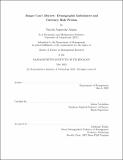| dc.contributor.advisor | Verdelhan, Adrien | |
| dc.contributor.author | Adams, Patrick Augustine | |
| dc.date.accessioned | 2022-08-29T16:03:22Z | |
| dc.date.available | 2022-08-29T16:03:22Z | |
| dc.date.issued | 2022-05 | |
| dc.date.submitted | 2022-06-09T14:33:29.042Z | |
| dc.identifier.uri | https://hdl.handle.net/1721.1/144667 | |
| dc.description.abstract | Empirically, countries with relatively old populations have significantly lower interest rates and currency returns. As a first step towards explaining this fact, I develop a two-country overlapping generations model to study the relationship between the global wealth distribution and currency risk premia. Relatively wealthy countries in the model have low currency risk premia because their bonds insure wealthy households against increases in the price of their own consumption basket. I discuss how the model can be extended to incorporate demographic heterogeneity across countries. Given observed household savings patterns over the life cycle, differences in population age across countries can potentially generate large differences in financial wealth and currency risk premia. | |
| dc.publisher | Massachusetts Institute of Technology | |
| dc.rights | In Copyright - Educational Use Permitted | |
| dc.rights | Copyright MIT | |
| dc.rights.uri | http://rightsstatements.org/page/InC-EDU/1.0/ | |
| dc.title | Jünger Can't Borrow: Demographic Imbalances and Currency Risk Premia | |
| dc.type | Thesis | |
| dc.description.degree | S.M. | |
| dc.contributor.department | Sloan School of Management | |
| mit.thesis.degree | Master | |
| thesis.degree.name | Master of Science in Management Research | |
